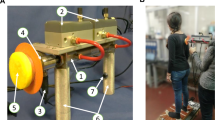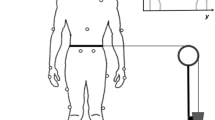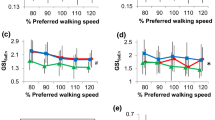Abstract
Background and aims: Recent studies have demonstrated that assuming the postural corrective torque is regulated by a proportional-integralderivative (PID) controller in the anterior/posterior direction, although few studies have discussed the medial/lateral (M/L) direction through PID control. Instability in the M/L direction has been reported to be closely related with the risk of falling in the elderly. The purpose of this study is to evaluate the mechanism of postural control in the M/L direction in the elderly. Methods: The movement of a marker on the subject’s back was measured by a CMOS video camera and trunk sway speeds in the M/L direction (TSSX) were calculated as absolute values in whole time series. Using trunk sway data, we identified the gain of PID parameters (proportional gain: K P, integral gain: K I derivative gain: K D). In addition, we calculated the frequency spectrum of trunk sway using the marker locus from 0.016 to 5 Hz by fast Fourier transform. A total of 40 healthy subjects aged from 20 to 85 years old was evaluated with the PID control algorithm in a model of postural control in the M/L direction and their parameter values were estimated. Results: K P significantly increased with age, whereas K D tended to decrease. The TSSX and power ratio of medium frequency (0.2-2.0 Hz) significantly increased with age, but the power ratio of low frequency (0.02-0.2 Hz) tended to decrease. K P and K I were significantly correlated with the power ratio of medium frequency. There was a significant negative correlation between K D and TSSX. Conclusions: Our results indicate that dependence on hip and ankle stiffness, which may be controlled by proportional gain, increases with age for postural control in the M/L direction. A disability in the feedback mechanism based on velocity information for postural control, which may be associated with derivative gain, tends to increase with age but shows considerable individual variation.
Similar content being viewed by others
References
Winter DA, Patla AB, Prince F, Ishac M, Gielo-Perczak K. Stiffness control of balance in quiet standing. J Neurophysiol 1998; 80: 1211–21.
Peterka RJ. Sensorimotor integration in human postural control. J Neurophysiol 2002; 88: 1097–118.
Maurer C, Peterka RJ. A new interpretation of spontaneous sway measures based on a simple model of human postural control. J Neurophysiol 2005; 93: 189–200.
Maki BE, Holliday PJ, Topper AK. A prospective study of postural balance and risk of falling in an ambulatory and independent elderly population. J Gerontol 1994; 49: 72–84.
Mitchell SL, Collins JJ, De Luca CJ, Burrows A, Lipsitz LA. Open-loop and closed-loop postural control mechanisms in Parkinson’s disease: increased mediolateral activity during quiet standing. Neurosci Lett 1995; 197: 133–6.
Tinetti ME, Speechley M, Ginter SF. Risk factors for falls among elderly persons living in the community. N Engl J Med 1988; 319: 1701–7.
Nagasaki S, Jiang Y, Furuta Y, Mohammad M, Matsuoka M, Kimura H. Falls risk prediction in old women: evaluated by trunk sway tests in static upright stance. J Educ Health Sci 2003; 43: 353–8.
Raymakers JA, Samson M, Verhaar HJ. The assessment of body sway and the choice of the stability parameter(s). Gait Posture 2005; 21: 48–58.
Johansson R, Magnusson M. Human postural dynamics. Biomed Eng 1991; 18: 413–37.
Morasso PG, Sanguineti V. Ankle muscle stiffness alone cannot stabilize balance during quiet standing. J Neurophysiol 2002; 88: 2157–62.
Allum JH, Carpenter MG, Honegger F, Adkin AL, Bloem BR. Age-dependent variations in the directional sensitivity of balance corrections and compensatory arm movement in man. J Physiol 2002; 542: 643–63.
Soames RW, Atha J. The spectral characteristics of postural sway behavior. Eur J Appl Physiol 1982; 49: 169–77.
Patla A, Winter D, Frank J, Walt S, Prasad S. Identification of agerelated changes in the balance-control system. In: Duncan P (Ed) Balance: Proceedings of the APTA Forum on Balance 1989; 43–55.
Dichgans J, Brandt T. Visual-vestibular interaction: effects on selfmotion perception and postural control. In: Held R, Leibowitz H, Teuber H (Eds) Handbook of Sensory Physiology, Vol. VIII: Perception. Berlin: Springer-Verlag; 1978: 756–804.
Berger W, Trippel M, Discher M, Dietz V. Influence of subjects’ height on the stabilization of posture. Acta Otolaryngol 1992; 112: 22–30.
Horstmann G, Dietz V. A basic posture control mechanism: the stabilization of the center of gravity. Electroencephalog Clin Neurophysiol 1990; 76: 165–76.
Allum J, Adkin A, Carpenter M, Held-Ziolkowska M, Honegger F, Pierchala K. Trunk sway measures of postural stability during clinical balance tests: effects of unilateral vestibular deficit. Gait Posture 2001; 14: 227–37.
Kapteyn TS, Bles W, Njiokiktjien CJ, Kodde L, Massen CH, Mol JM. Standardization in platform stabilometry being a part of posturography. Agressologie 1983; 24: 321–6.
Winter DA, Patla AE, Frank JS. Assessment of balance control in humans. Med Prog Technol 1990; 16: 31–51.
van der Kooij H, Jacobs R, Koopman B, van der Helm F. An adaptive model of sensory integration in a dynamic environment applied to human stance control. Biol Cybern 2001; 84: 103–15.
Jeka JJ, Oie K, Schoner G, Dijkstra T, Henson E. Position and velocity coupling of postural sway to somatosensory drive. J Neurophysiol 1998; 79: 1661–74.
Masani K, Popovic MR, Nakazawa K, Kouzaki M, Nozaki D. Importance of body sway velocity information in controlling ankle extensor activities during quiet stance. J Neurophysiol 2003; 90: 3774–82.
Peterka RJ. Postural control model interpretation of stabilogram diffusion analysis. Biol Cybern 2000; 82: 335–43.
Horak FB. Postural orientation and equilibrium: what do we need to know about neural control of balance to prevent falls? Age Ageing 2006; 35: 7–11.
Kapteyn TS, de Wit G. Posturography as an auxiliary in vestibular investigation. Acta Otolaryngol 1972; 73: 104–11.
Bronstein AM. Suppression of visually evoked postural responses. Exp Brain Res 1986; 63: 655–8.
Hurley MV, Rees FJ, Newham DJ. Quadriceps function, proprioception acuity and functional performance in healthy young, middle-aged, and elderly subjects. Age Ageing 1998; 27: 55–62.
Horak FB, Nashner LM. Central programming of postural movements: adaptation to altered support-surface configurations. J Neurophysiol 1986; 55: 1369–81.
Lacour M, Bernard-Demanze L, Dumitrescu M. Posture control, aging, and attention resources: models and posture-analysis methods. Clin Neurophysiol 2008; 38: 411–21.
Collins J, Deluca CJ, Burrows A, Lipsitz LA. Age-related changes in open-loop and close-loop postural control mechanisms. Exp Brain Res 1995; 104: 480–92.
Author information
Authors and Affiliations
Corresponding author
Rights and permissions
About this article
Cite this article
Nishihori, T., Aoki, M., Jiang, Y. et al. Effects of aging on lateral stability in quiet stance. Aging Clin Exp Res 24, 162–170 (2012). https://doi.org/10.3275/7626
Received:
Accepted:
Published:
Issue Date:
DOI: https://doi.org/10.3275/7626




